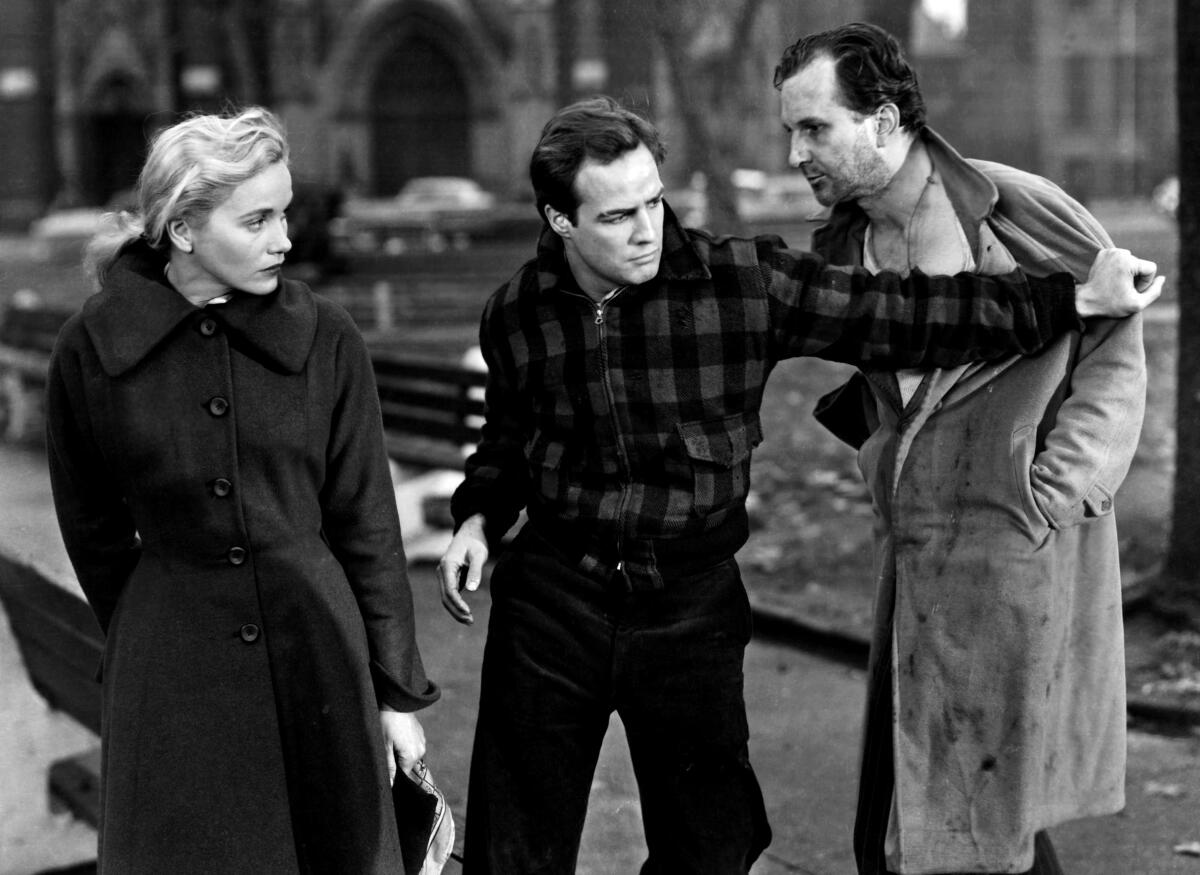From the Archives: ‘On Waterfront,’ Sootily realistic, looms as dark horse film of ‘54

- Share via
To old-timers this new black-and-white work of artistry will recall the powerful photoplays of D. W. Griffith. It has the sooty realism of the films of the late, great director made in and around New York; a quality of love scene so sweetly intimate that it makes the eavesdropper feel as though he’s prying, and the same basic, heroic-scale conflict between good and evil, finally erupting like the breath from bursting lungs.
Kickback — or Else
For latercomers, the comparison will be to the Warner gangland sagas of of the early 30s, the “Public Enemies” and the “Little Caesars.” Or perhaps to “Winterset.”
The leading antagonists in “On the Waterfront” ARE gangsters — members of the shape-up and shakedown racket which has terrorized the eastern seaboard for years — and still does, though in reduced degree. “Shape-up” is the term for preferential hiring of stevedores and other dockworkers; “shakedown” means exactly what it says, and it took — and takes — the form of kickbacks in “dues” to a “union” ruled by thugs.
The leading protagonists are a priest who fights back, the New York State Crime Commission, a punchy ex-pug who is shamed and goaded into standing up to “the system,” and the girl who believes in him.
Authentic Sources
The story’s sources are Father John M. Corridan, a 42-year-old Jesuit priest who became a national figure for his work in behalf of the longshoremen; Malcolm Johnson, whose newspaper exposé “Crime on the Waterfront” won him the Pulitzer Prize for reporting in 1949, and Arthur J. (Brownie) Browne, dockworker for 30 years at the Port of New York and technical adviser on the film.
Elia Kazan, who produced and directed it, told me “‘On the Waterfront’ is God’s truth. The New York longshoremen are just exactly as depicted: I have lived and worked among them, and I know. I do not say this condition is true of all American labor, because it isn’t.”
Actress Introduced
Kazan directed the picture from a final screenplay by Budd Schulberg for Sam Spiegel’s Horizon company and a Columbia release. His stars are Marlon Brando, Karl Malden and Lee J. Cobb, with Eva Marie Saint “introduced.” In the cast are many members of Kazan’s Actors’ Studio — as well as the remarkable atmospheric types he is so adept at turning into actors on the spot.
Kazan has directed Brando on two previous occasions — in “A Streetcar Named Desire” (also with Malden) and “Viva Zapata!” His two most recent directorial efforts were “Man on a Tightrope” (screen) and “Tea and Sympathy” (stage). Schulberg is known for his novels, short stories and, in the last couple of years, his anti-communist articles. Spiegel, otherwise the “late” S. P. Eagle, was executive producer on “The African Queen” and “Melba.”
The score of the picture, which is as extraordinary as the picture itself, is Composer-Conductor Leonard Bernstein’s first for Hollywood.
But in the literal sense, Hollywood had very little to do with “On the Waterfront.” It was photographed (by Boris Kaufman) in Hoboken, N.J., against the omnipresent Manhattan skyline, in the often freezing period from Nov. 17, 1953 to June 26, 1954. Wharf, piers, ships, hotel, bar, church, park, streets (“all that wonderful old red brick,” quoth Kazan), tenements, even the floating shack on which the final showdown takes place, are actual settings.
The shack, 67 years old, is referred to by local wags as “the Hoboken Yacht Club.” It will never be the same now.
Hoboken as Port
Brando plays the ex-pug, Malden the parish priest, Cobb the waterfront boss and Miss Saint the girl. Others prominent are Rod Steiger, Pat Henning, Leif Erickson and James Westerfield. Boss Cobb’s pluguglies include three ex-boxers: Tony Galento, Abe Simon and Tami Mauriello. The principals, no less than these old pros, seem to live rather than act their parts.
The story begins on a shrill note of horror: Joey Doyle, a kid who raises pigeons and is himself about to sing to the crime commission, is shoved off his aviary roof. Brando had lured him to the spot as a favor to the racket boss, figuring they would only “lean on” the kid a little bit. But this is different; after all, Brando raises pigeons himself.
Later he meets Miss Saint, Joey’s sister, and she, suspecting that he knows something, goes to work on his conscience. So does the priest. So does the crime commission.
From then on Marlon doesn’t draw an easy breath; and neither, when he sees “On the Waterfront,” will the moviegoer.
More to Read
Only good movies
Get the Indie Focus newsletter, Mark Olsen's weekly guide to the world of cinema.
You may occasionally receive promotional content from the Los Angeles Times.










